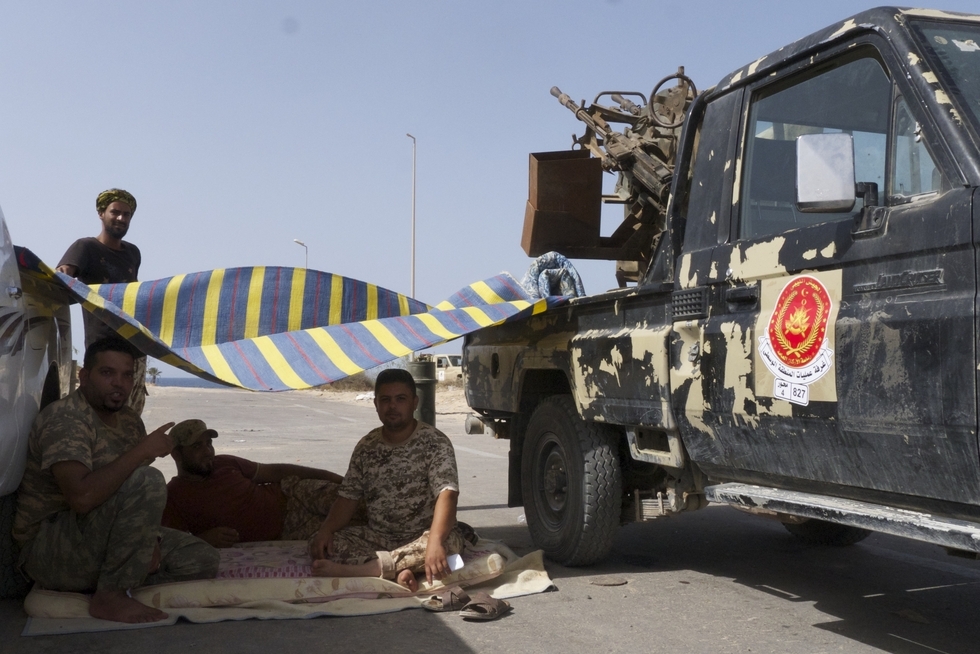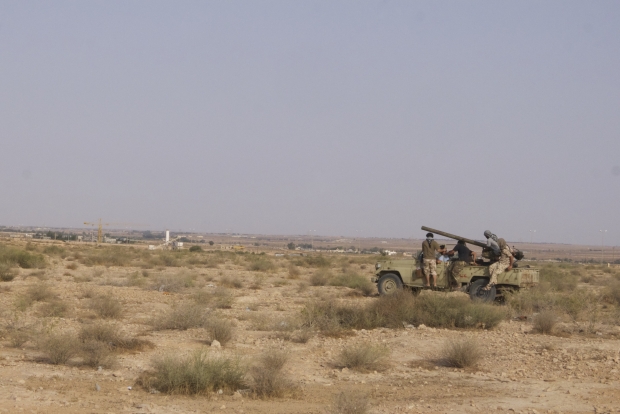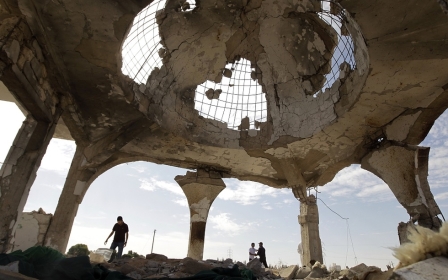Inside former IS-held city in Libya: Secret prisons, bomb workshops

SIRTE, Libya - Libyan forces battling against the Islamic State (IS) in Sirte have unearthed evidence of the group’s reign of terror in the town it has claimed as its North African stronghold for over a year.
Behind the pink walls and trailing flowers of a luxurious villa near Sirte’s industrial district, advancing troops discovered an abandoned IS jail where, behind roughly bricked-up windows, prisoners had been kept in deplorable conditions.
“We found four Libyans imprisoned here, all from Sirte,” Hamid, one of the soldiers who took over the jail, told MEE. “They were in a very bad condition. They had been mistreated and were close to death when we found them. They had been left with no food or water and were starving to death.”
The four Libyan prisoners were found in the smallest cells, just big enough for a mattress. The men were kept in inhumane conditions - in complete darkness, with only a fan to circulate air in a region where summer temperatures often reach more than 40 degrees celsius. The airless chambers stank of stale urine where prisoners, unable to access the separate toilet cubicle after IS abandoned the premises, had been forced to relieve themselves in their tiny cells.
Seven larger cells, also without electricity, contained four or five mattresses, indicating the prison had the capacity to hold more than 30 people. The small jail had been maximum-security, with grills covering the fans, to prevent desperate prisoners from trying to escape through the small openings and video cameras installed around the premises to constantly monitor inmates.
Hamid said he believed that IS militants had taken other prisoners with them when they fled the area a week ago. Amongst upturned suitcases and piles of clothes - possibly the possessions of former inmates - were English language textbooks and used medicines, including insulin. Sheets of paper with Islamic and Arabic lessons written in English indicated that IS members had forced prisoners to study Islam, and that some of those prisoners were English-speakers.
On a small piece of cardboard - a label from a pair of socks - the dates for the month of April had been meticulously written out, with notes detailing a change of prison and interrogation sessions. At the bottom of the paper was written: “3 Indian Doctors imprisonment Sirt University, Sirt, by IS,” along with the first date of their incarceration, matching the date of the abduction of Indian doctors and teachers working in Sirte.
In July 2015, four Indian teachers and doctors were captured at an IS checkpoint outside Sirte. Two, who were either Muslim or who were well-informed about Islam, were released within days. The other two - both Hindus - were not, and, in September, two more Indian workers were seized, one of whom managed to escape. The Indian embassy in Libya confirmed that six of its citizens disappeared in Sirte last year, three of whom remained missing.
The last date on the piece of cardboard was 30 April 2016. It is not clear what become of the men after that date.
“Daesh [IS] never used official prisons in Sirte because all the local people knew where those were,” said former Sirte resident Ahmed, explaining that the villa was one of many properties in the town commandeered by IS and used for the group’s nefarious purposes.
“Instead, they made secret prisons inside normal houses, like this one.” He said hundreds of Sirte residents had disappeared during IS’s year-long reign of terror in the town, adding that it was not known whether they were now being held inside the areas of Sirte currently occupied by IS, or whether they had been been killed.
Libyan forces operating under the UN-backed Government of National Accord (GNA) have been battling against IS militants in central coastal Libya since early May. They now surround Sirte with steadily-progressing front lines encroaching into the area IS still controls, supported by daily air bombardments by military jets from Libya’s third city of Misurata. Commander on the frontline in Sirte’s Zafaran district Mohamed Issa estimated that IS-occupied territory had been reduced to a maximum of 18 square kilometres, with new pockets of Sirte being captured from IS almost daily.
The bomb-making factory
In a recently captured Sirte district known as the Arches, GNA forces discovered a sprawling area used as a makeshift explosives factory, where IS had prepared car bombs and hand-crafted other explosive devices, including grenades.
“We found a lot of explosives of the sort used in car bombs stored in several places here,” explained soldier Ibrahim. “This was like a headquarters for Daesh weaponry and they made a lot of devices and booby-traps themselves here, out of scrap metal.”
The corner of one building was reserved for fashioning grenades, and pieces of metal and tools still lay scattered on the ground. “They scored a grid deep into the metal tube, to make it operate like a real grenade so, on impact, the separate pieces of metal would fly out in all directions,” he explained, holding out one of the roughly-hewn devices.
“We also found a lot of other items, including pieces of scrap metal, that Daesh used in their car bombs, to create shrapnel to make the explosion more lethal and cause the maximum damage and injuries,” Ibrahim said.
IS has relied heavily on mines, suicide bombers and IEDs in its defence of Sirte, and such devices have been responsible for many of the 210 deaths and over 1,000 injuries already sustained by the GNA forces.
“We never saw these kind of things when we were fighting in 2011,” said Abdul Latif Riad, a fighter confined to a Misurata hospital bed for the last five days, after shrapnel ricochetting from a mortar explosion blew apart his foot, severing two toes.
“We found that Daesh has specialist people who know how to prepare mines and IEDs by hand. Either these people come from outside Libya, or they have been trained how to make these devices because, in 2011, we were only dealing with face-toeface fighting, not these kind of IEDs.”
He added that such tactics continued to be one of the biggest dangers faced by Libyan fighters trying to capture Sirte from IS.
Like many other premises, the explosives workshop had been abandoned hastily, as the GNA troops advanced through the outskirts of Sirte.
Beside a wall with ‘Islamic State’ written, in English, in large capital letters, six pairs of sandals and a single pair of army boots lay abandoned near a rug where militants had either prayed, rested or eaten. On one of the workshop tables lay the dust jacket for a copy of former US Secretary of Defence Robert M Gates’ memoirs.
This article is available in French on Middle East Eye French edition.
Middle East Eye propose une couverture et une analyse indépendantes et incomparables du Moyen-Orient, de l’Afrique du Nord et d’autres régions du monde. Pour en savoir plus sur la reprise de ce contenu et les frais qui s’appliquent, veuillez remplir ce formulaire [en anglais]. Pour en savoir plus sur MEE, cliquez ici [en anglais].





